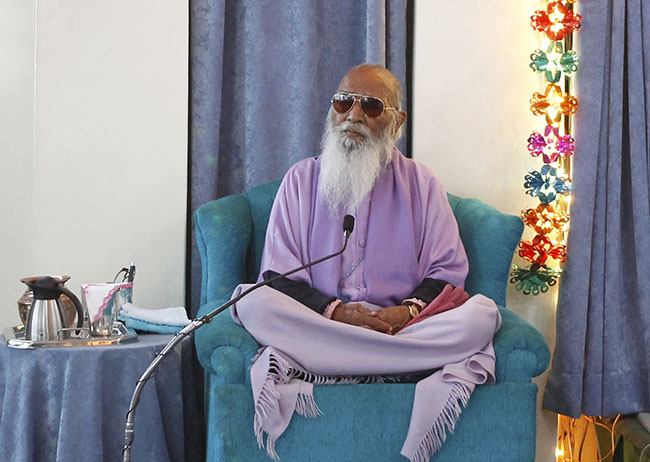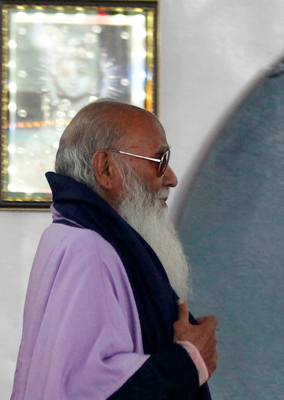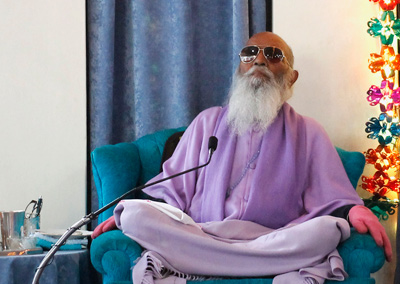These Are a Kind of Words of a Flute

Speaker: …The lap has a feeling, and you know it. It is a place which is freedom from the body-sense. I think that is why I keep wanting to come back to that lap.
Swamiji: That lap is for a child. For a child, there is a lap. When you reach the stage where you feel, “I am in the lap,” you became that child—who has no language, no form, no name. It is not easy for a human being to be that. Luckiest are those people who reached the state where they feel they are in the lap. It is called Guru.
The trouble for human eyes is that, with them, a human being thinks that Guru is a form. A husband sees his wife; he thinks she is a form. She sees her husband; she thinks he is a form. When you close the eyes, forms do not exist. Only that lap exists. That lap is known by various names, which Guru uses. But I will not use names, because that has no name and no form. So I will use only words, which are not solid.
 A flute is from bamboo, which speaks. Bamboo does not speak. Bamboo is not solid outside, not solid inside. Yet, a piece of bamboo speaks. Who speaks? The Self. The Self is that lap, that sound, that Pure Awareness, that Pure Existence. That can whisper. And that can be out loud. But it is.
A flute is from bamboo, which speaks. Bamboo does not speak. Bamboo is not solid outside, not solid inside. Yet, a piece of bamboo speaks. Who speaks? The Self. The Self is that lap, that sound, that Pure Awareness, that Pure Existence. That can whisper. And that can be out loud. But it is.
You are hearing the hammering of a carpenter. If a dead man is there, he cannot hammer. If a dead man is there, he cannot whisper. Therefore, it is not dead. It is Pure. It is not obvious. It is not unobvious. It is not born. It is not dead. It has no name, no form. It is always ever present—where time does not exist, place does not exist, causation does not exist. Yet, time exists, place exists, causation exists. That is why a born human being remains confused. This confusion can be removed only in satsang, when you reach in the lap of Guru.
When you are in the lap, the child does not have to know his mother and he does not have to know the cradle. He is just there. He is fully alive, smiling, active. Yet he does not know the language of human beings. But, as human beings do, when he becomes big, he has language. Language has a drawback: it remains language for a hundred years and it never stops. It stops only when you come to Guru and you feel—it is real expression—that I is the lap.
But we have our language, and so we say, “I am a person who is in the lap.” Reverse it: I. I. Previous to birth, it is I. After birth, it is I. When birth is over, it is I. That I is the Self. The Self alone is—which is unseen. In milk, ghee is there, but it is not seen. In an oyster, silver is there, but it is not seen. In a desert, river water is there, but it is not seen. For a sleepy man who sees two moons, the moon is not there.
It is ever present, one moon. That one is hidden in every second, third, fourth, fifth and millionth—but it is always One. That Oneness is Siddhant (Principle, beyond time and space). It is not any Upanishad. It is not any doubt of a man. It is not any proof. It is not any time to discuss. It is not a place to be found. It is Siddhant, which means that is the only One, or Oneness.
The moment a human being is in relation, a child with a toy, he is caught. For he thinks he is one and the toy is another. He is one aham (I) and the toy is twam (you). This is rag and dwaysh—you all know attachment and aversion. “I love myself, as this body.” Rag. “I do not care for your body. You can go, you can be here, there, anywhere.” It is dwaysh. If mind is there, rag and dwaysh is a must. Therefore, let us be free from the mind. … [Meditation]
In satsang, each one has come to know that the carpenter and his tools are inseparable—which means that neither the carpenter is there, nor his tools are there.  A born human being does not know this. Yet, he wants to know. So again and again he asks, “Who am I? A carpenter? Or am I learning words, names and forms?” Again and again Guruji says, “You are none of them.” But he does not listen.
A born human being does not know this. Yet, he wants to know. So again and again he asks, “Who am I? A carpenter? Or am I learning words, names and forms?” Again and again Guruji says, “You are none of them.” But he does not listen.
So as long as he is attending satsang and he is not able to listen, he should continue Amaram Hum Madhuram Hum (I am unborn, I am deathless), Poornamadaha Poornamidam (Everything is the field of one unstruck sound, which is the Whole). He is neither born, nor is he going to die. Neither is he a carpenter, nor is he gathering tools. Both are not.
Pure Free Forever is you. If you hear it again and again, it is just possible that some day you can listen to Guru, who says, “Neither man is born, nor the world is visible.” They are very profound words. But they do not make any sense which an intellectual makes. These are a kind of words of a flute.
Copyright © 1999-2015 International
Meditation Institute. All Rights Reserved